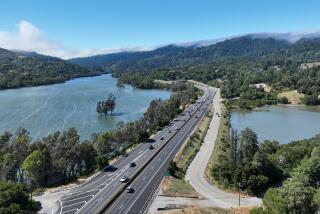Caltrans’ Proposed Roundabout Raises Ruckus Around Ojai
- Share via
The circular intersection that Caltrans wants to build in Ojai has residents going ‘round and ‘round debating its merits.
One group, which says it has collected more than 1,000 signatures opposing the project, contends that the idea for the roundabout at the Y-intersection of California 33 and California 150 is unsafe and untested.
“The people of Ojai don’t want this experiment in their busiest intersection,” said Craig Walker, spokesman for Citizens for Safe Driving in Ojai. “Most people say, ‘I’ve driven in those things and they’re a mess.’ ”
But another group, which is launching a petition drive this weekend in support of the plan, says the British-style circle is a safe way of regulating traffic and will reduce delays.
“It’s a very, very good concept,” said Margot Eiser, who will hold a pro-roundabout party Saturday at Time Portal, the Ojai bookstore that she runs with her husband. “I don’t like to stop while I’m driving.”
Their arguments will be aired Wednesday at an Ojai Planning Commission meeting, the city’s first public hearing on the project since the state Department of Transportation proposed building the roundabout more than a year ago.
Caltrans hopes the Ojai roundabout, which would differ from other rotaries in this country primarily by assigning the right of way to cars already traveling within the circle, will serve as a prototype for other such intersections in the state.
Caltrans, which has budgeted $250,000 for the project, is not required to obtain permission from Ojai officials, but the agency has said it will not proceed without local support.
In a five-page report criticizing the proposal, Walker compares the British-style roundabout to the obsolete metric-conversion plan of the 1970s when Americans were either unable or unwilling to accept a European system, regardless of its merits.
He also argues that the circular intersection is hazardous because its less-structured design encourages risky maneuvers from aggressive motorists and intimidates more conservative drivers.
“Those caught up in the roundabout fantasy need to look more closely at the realities of the roundabout to avoid a project that will not only cost money and result in confusion, but may also cost lives,” wrote Walker, a computer and psychology instructor at Nordhoff Senior High School.
However, Leif Ourston, project consultant for Caltrans, said such fears are unfounded.
By eliminating traffic signals and the hazard of head-on traffic, roundabouts typically reduce accidents by 40% to 60%, Ourston said. The 23 accidents at the Ojai intersection over the last 3 1/2 years could easily be cut in half, he said.
Ourston will present his fifth revision of the roundabout design at next week’s Planning Commission meeting. He said there is no evidence that American drivers cannot adjust to new driving habits.
After the proposal is reviewed by the Planning Commission, the Ojai City Council is expected to consider the project at a Feb. 23 meeting.
More to Read
Sign up for Essential California
The most important California stories and recommendations in your inbox every morning.
You may occasionally receive promotional content from the Los Angeles Times.













